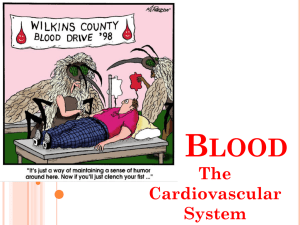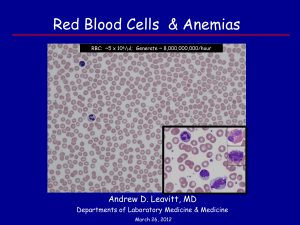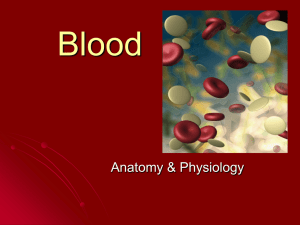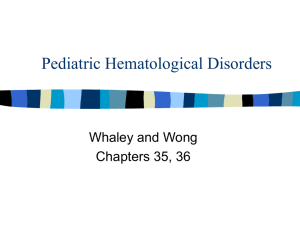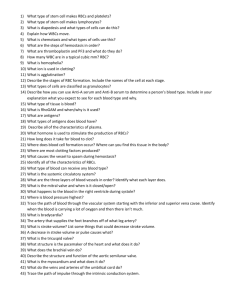phys chapter 32 [10-19
advertisement
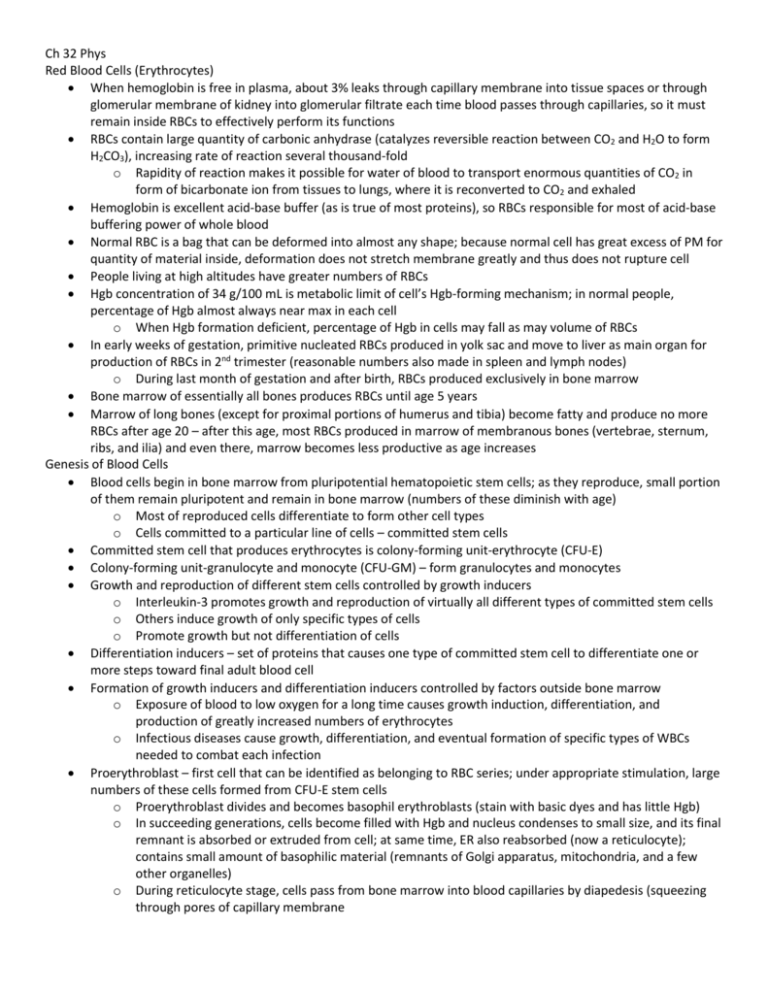
Ch 32 Phys Red Blood Cells (Erythrocytes) When hemoglobin is free in plasma, about 3% leaks through capillary membrane into tissue spaces or through glomerular membrane of kidney into glomerular filtrate each time blood passes through capillaries, so it must remain inside RBCs to effectively perform its functions RBCs contain large quantity of carbonic anhydrase (catalyzes reversible reaction between CO2 and H2O to form H2CO3), increasing rate of reaction several thousand-fold o Rapidity of reaction makes it possible for water of blood to transport enormous quantities of CO2 in form of bicarbonate ion from tissues to lungs, where it is reconverted to CO2 and exhaled Hemoglobin is excellent acid-base buffer (as is true of most proteins), so RBCs responsible for most of acid-base buffering power of whole blood Normal RBC is a bag that can be deformed into almost any shape; because normal cell has great excess of PM for quantity of material inside, deformation does not stretch membrane greatly and thus does not rupture cell People living at high altitudes have greater numbers of RBCs Hgb concentration of 34 g/100 mL is metabolic limit of cell’s Hgb-forming mechanism; in normal people, percentage of Hgb almost always near max in each cell o When Hgb formation deficient, percentage of Hgb in cells may fall as may volume of RBCs In early weeks of gestation, primitive nucleated RBCs produced in yolk sac and move to liver as main organ for production of RBCs in 2nd trimester (reasonable numbers also made in spleen and lymph nodes) o During last month of gestation and after birth, RBCs produced exclusively in bone marrow Bone marrow of essentially all bones produces RBCs until age 5 years Marrow of long bones (except for proximal portions of humerus and tibia) become fatty and produce no more RBCs after age 20 – after this age, most RBCs produced in marrow of membranous bones (vertebrae, sternum, ribs, and ilia) and even there, marrow becomes less productive as age increases Genesis of Blood Cells Blood cells begin in bone marrow from pluripotential hematopoietic stem cells; as they reproduce, small portion of them remain pluripotent and remain in bone marrow (numbers of these diminish with age) o Most of reproduced cells differentiate to form other cell types o Cells committed to a particular line of cells – committed stem cells Committed stem cell that produces erythrocytes is colony-forming unit-erythrocyte (CFU-E) Colony-forming unit-granulocyte and monocyte (CFU-GM) – form granulocytes and monocytes Growth and reproduction of different stem cells controlled by growth inducers o Interleukin-3 promotes growth and reproduction of virtually all different types of committed stem cells o Others induce growth of only specific types of cells o Promote growth but not differentiation of cells Differentiation inducers – set of proteins that causes one type of committed stem cell to differentiate one or more steps toward final adult blood cell Formation of growth inducers and differentiation inducers controlled by factors outside bone marrow o Exposure of blood to low oxygen for a long time causes growth induction, differentiation, and production of greatly increased numbers of erythrocytes o Infectious diseases cause growth, differentiation, and eventual formation of specific types of WBCs needed to combat each infection Proerythroblast – first cell that can be identified as belonging to RBC series; under appropriate stimulation, large numbers of these cells formed from CFU-E stem cells o Proerythroblast divides and becomes basophil erythroblasts (stain with basic dyes and has little Hgb) o In succeeding generations, cells become filled with Hgb and nucleus condenses to small size, and its final remnant is absorbed or extruded from cell; at same time, ER also reabsorbed (now a reticulocyte); contains small amount of basophilic material (remnants of Golgi apparatus, mitochondria, and a few other organelles) o During reticulocyte stage, cells pass from bone marrow into blood capillaries by diapedesis (squeezing through pores of capillary membrane o Remaining basophilic material in reticulocyte normally disappears in 1-2 days and cell is then mature erythrocyte Regulation of RBC Production – Role of Erythropoietin Total mass of RBCs in circulatory system regulated within narrow limits so adequate RBCs always available to provide sufficient transport of oxygen from lungs to tissues, yet cells do not become so numerous that they impede blood flow Destruction of major portions of bone marrow by any means causes hyperplasia of remaining bone marrow, thereby attempting to supply demand for RBCs in body At very high altitudes, where quantity of oxygen in air greatly decreased, insufficient O2 transported to tissues, and RBC production greatly increased Prolonged cardiac failure and many lung diseases cause excess RBC production because of tissue hypoxia Principal stimulus for RBC production in low oxygen states is erythropoietin (glycoprotein hormone); in absence of erythropoietin, hypoxia has little or no effect to stimulate RBC production About 90% of all erythropoietin formed in kidneys and remainder mainly in liver o Renal tissue hypoxia leads to increased tissue levels of hypoxia-inducible factor-1 (HIF-1), which serves as transcription factor for large number of hypoxia-inducible genes, including erythropoietin gene o HIF-1 binds to hypoxia response element residing in erythropoietin gene, inducing transcription o At times, hypoxia in other parts of body, but not in kidneys, stimulates kidney erythropoietin secretion o Norepinephrine and epinephrine and several prostaglandins stimulate erythropoietin production o If kidneys no longer able to produce erythropoietin, person would only get 1/3-1/2 of needed erythropoietin and would thus become anemic When person placed in low O2 atmosphere, erythropoietin begins to be formed in minutes to hours and reaches maximum production in 24 hours; almost no new RBCs appear in circulating blood until 5 days later o Erythropoietin stimulates production of proerythroblasts from hematopoietic stem cells in marrow o Once proerythroblasts formed, erythropoietin causes cells to pass more rapidly through different erythroblastic stages than normal, speeding up production of new RBCs When person has enough RBCs to sustain (or if removed from low O2 environment), rate of erythropoietin production decreases to level that will maintain required number of RBCs but not excess In absence of erythropoietin, few RBCs formed by marrow Maturation of RBCs – Requirement for Vitamin B12 and Folic Acid Because of continuing need to replenish RBCs, erythropoietic cells of marrow are among most rapidly growing and reproducing cells in entire body Especially important for final maturation of RBCs are vitamin B12 and folic acid because each is required for formation of thymidine triphosphate (one of essential building blocks of DNA) In B12 and folic acid deficiency, erythroblastic cells of marrow produce mainly larger than normal RBCs (macrocytes) and cell itself has flimsy membrane and often irregular, large, and oval instead of biconcave disc o Poorly formed cells, after entering circulation, capable of carrying oxygen normally, but fragility causes them to have a short life (1/2-1/3 normal) Deficiency of either vitamin B12 or folic acid causes maturation failure of erythropoiesis Common cause of RBC maturation failure is failure to absorb B12 from GI tract as occurs in pernicious anemia (atrophic gastric mucosa that fails to produce normal gastric secretions) o Intrinsic factor made by parietal cells combines with B12 and makes it available for absorption Intrinsic factor binds tightly with vitamin B12, causing B12 to be protected from digestion by gastrointestinal secretions Intrinsic factor-B12 complex binds to specific receptor sites on brush border membranes of mucosal cells in ileum B12 transported into blood during next few hours by pinocytosis, carrying intrinsic factor and vitamin together through membrane o Once B12 absorbed form GI tract, it is stored in large quantities in liver and then released slowly as needed by bone marrow (3-4 years of deficiency required to cause maturation failure anemia) Sprue – GI absorption abnormalities that cause serious difficulty absorbing both folic acid and B12 Synthesis of Hgb begins in proerythroblasts and continues into reticulocyte stage of RBCs; when reticulocytes leave bone marrow and pass into blood stream, they continue to form minute quantities of Hgb for another day or so until they become mature erythrocytes Hemoglobin formation o Succinyl-CoA (formed in Krebs cycle) binds with glycine to form pyrrole molecule o 4 pyrroles combine to form protoporphyrin IX, which combines with iron to form heme molecule o Each heme molecule combines with long polypeptide chain (globin synthesized by ribosomes), forming hemoglobin chain (hemoglobin subunit) o 4 hemoglobin chains bind together loosely to form whole hemoglobin molecule Because each hemoglobin chain has heme prosthetic group containing an atom of iron, and because there are 4 hemoglobin chains in each hemoglobin molecule, 4 iron atoms are in each hemoglobin molecule and each can bind loosely with one molecule of oxygen (4 molecules of O2 can be carried per hemoglobin molecule) Sickle cell anemia – valine substituted for glutamic acid at one point in each of 2 beta chains; when exposed to low O2, it forms elongate crystals inside RBCs, making it almost impossible for cells to pass through many small capillaries, and spiked ends of crystals likely to rupture cell membranes Oxygen binds loosely with one of coordination bonds of iron atom (extremely loose bond) Oxygen carried as molecular oxygen (O2) to tissues, where it is released into tissue fluids still as O2 Iron Metabolism 65% of body iron is in hemoglobin, 4% in myoglobin, 1% in various heme compounds that promote intracellular oxidation, 0.1% combined with transferrin in blood plasma, 15-30% stored for later use mainly in reticuloendothelial system and liver parenchymal cells (mostly in form of ferritin) When iron absorbed from small intestine, it is immediately combined with beta globulin (apotransferrin) to form transferrin; iron loosely bound to transferrin and can be released to any tissue cell at any point in body Excess iron deposited especially in liver hepatocytes and less in reticuloendothelial cells of bone marrow In cell cytoplasm, iron combines mainly with protein apoferritin to form ferritin; various amounts of iron can bind to apoferritin as iron radicals; iron stored as ferritin called storage iron o Ferritin particles so small and dispersed they usually can only be seen with electron microscope Smaller quantities of iron in storage pool in extremely insoluble form (hemosiderin), especially when total quantity of iron in body is more than apoferritin storage pool can accommodate o Hemosiderin collects cells in form of large clusters that can be seen with microscope When quantity of iron in plasma falls low, some of iron in ferritin storage pool removed easily and transported in form of transferrin in plasma to areas of body where needed o Transferrin molecule unique because it binds strongly with receptors in PM of erythroblasts in marrow, where it is ingested into erythroblasts by endocytosis and transferrin delivers iron directly to mitochondria, where heme synthesized o People with inadequate quantities of transferrin in blood, failure to transport iron to erythroblasts can cause severe hypochromic anemia When RBCs have lived their life span and are destroyed, Hgb released from cells ingested by monocytemacrophage cells and iron liberated and stored mainly in ferritin pool to be used as needed for Hgb formation Liver secretes moderate amounts of apotransferrin into bile, which flow through bile duct into duodenum where it binds with free iron and certain iron compounds (hgb and myoglobin in meat) o Transferrin attracted to and binds with receptors in membranes of intestinal epithelial cells o Transferrin molecule ingested by pinocytosis and is later released into blood capillaries as plasma transferrin o Only small proportions of iron can be absorbed at a time o When body has become saturated with iron so essentially all apoferritin in iron storage areas already combined with iron, rate of additional iron absorption from intestinal tract becomes greatly decreased o When iron stores have become depleted, rate of absorption can accelerate 5x more than normal Life Span of RBCs Even though mature RBCs do not have nucleus, mitochondria, or ER, they have cytoplasmic enzymes capable of metabolizing glucose and forming small amounts of ATP; enzymes o Maintain pliability of PM o Maintain membrane transport of ions o Keep iron of cells’ hemoglobin in ferrous form rather than ferric form o Prevent oxidation of proteins in RBCs Metabolic systems of old RBCs become progressively less active and cells become more and more fragile, presumably because life processes wear out o Once membrane becomes fragile, cell ruptures during passage through some tight spot in circulation o Many RBCs self-destruct in spleen, where they squeeze through red pulp of spleen o When spleen removed, number of old RBCs circulating in blood increases considerably When RBCs burst and release hemoglobin, it is phagocytized almost immediately by macrophages, especially in Kupffer cells of liver and macrophages of spleen and bone marrow o During next few hours to days, macrophages release iron from hemoglobin and pass it back into blood to be carried by transferrin either to bone marrow for production of new RBCs or to liver and other tissues for storage in form of ferritin o Porphyrin portion of hgb molecule converted by macropahges into bilirubin, which is released into blood and later removed from body by secretion through liver into bile Anemias Anemia – deficiency of hemoglobin in blood Blood loss anemia – gives rise to microcytic, hypochromic anemia; usually caused by chronic bleed (intestine cannot absorb iron fast enough to replace) Aplastic anemia – bone marrow aplasia caused by high-dose radiation or chemotherapy or other exposure to toxic agents (benzene from gasoline or insecticides); in lupus erythematosus, immune system attacks healthy cells such as bone marrow stem cells; people usually die unless treated by blood transfusions (temporarily increases numbers of RBCs) or bone marrow transplant (cures) Megaloblastic anemia – lack of B12, folic acid, or intrinsic factor, which causes RBCs to grow too large with odd shapes o Can develop in patients with atrophy of stomach mucosa, total gastrectomy, intestinal sprue o Erythroblasts cannot proliferate rapidly enough to form normal numbers of RBCs, so those that are formed have fragile membranes; cells rupture easily, leaving person in dire need of RBCs Hemolytic anemia – fragile RBCs rupture easily as they go through capillaries, especially spleen; even though number of RBCs formed may be normal, life span is so short that cells destroyed faster than they can be formed o Hereditary spherocytosis – RBCs very small and spherical o Sickle cell anemia – cells have abnormal HbS containing faulty beta chains in Hgb molecule When HbS exposed to low concentrations of oxygen, it precipitates into long crystals inside RBC Crystals elongate cell giving it sickle appearance Precipitated Hgb damages PM so cells become highly fragile Patients frequently experience circle of events leading to times of crisis in which low oxygen tension in tissues causes sickling, which leads to ruptured RBCs, which causes further decrease in oxygen tension and still more sickling and RBC destruction o Erythroblastosis fetalis – Rh-positive RBCs in fetus attacked by antibodies from Rh-negative mother Antibodies make Rh-positive cells fragile, leading to rapid rupture and causing child to be born with serious anemia Extremely rapid formation of new RBCs to make up for destroyed cells causes large number of early blast forms of red cells to be released from Viscosity of blood depends largely on blood concentration of RBCs; in severe anemia, blood viscosity may fall to half normal; decreased viscosity decreases resistance to blood flow in peripheral blood vessels, so far greater than normal quantities of blood flow through tissues and return to heart, thereby greatly increasing cardiac output o Hypoxia resulting from diminished transport of oxygen by blood causes peripheral tissue blood vessels to dilate, allowing further increase in return of blood to heart and increasing cardiac output to higher still, increasing pumping workload on heart o Increased cardiac output in anemia partially offsets reduced oxygen-carrying effect of anemia because even though each unit quantity of blood carries only small quantities of oxygen, rate of blood flow may be increased enough that almost normal quantities of oxygen are actually delivered to tissues o When a person with anemia begins to exercise, heart not capable of pumping much greater quantities of blood than it is already pumping, so with increased tissue demand for oxygen, extreme tissue hypoxia results and acute cardiac failure may ensue Polycythemia Whenever tissues become hypoxic because of too little oxygen in breathed air, such as high altitudes, or because of failure of oxygen delivery to tissues, such as in cardiac failure, blood-forming organs automatically produce large quantities of extra RBCs – secondary polycythemia o Common type of secondary polycythemia is physiologic polycythemia – occurs in natives of areas high altitude; blood count is higher, allowing people to perform reasonably high levels of continuous work even in rarefied atmosphere Polycythemia vera (erythemia) – pathological condition in which RBC count and hematocrit increased o Caused by genetic aberration in hemocytoblastic cells that produce blood cells; blast cells no longer stop producing RBCs when too many cells present, causing excess production of RBCs (usually causes excess production of WBCs and platelets too) o Total blood volume also increases, so entire vascular system becomes intensely engorged o Many capillaries become plugged by viscous blood, and viscosity increases to more than 3x normal Because of increased viscosity of blood, blood flow through peripheral blood vessels sluggish o Increasing viscosity decreases rate of venous return to heart, but blood volume greatly increased, which tends to increase venous return; these two balance each other so cardiac output not far from normal o Arterial pressure normal (in about 1/3 of patients is elevated) – blood pressure-regulating mechanisms can usually offset tendency for increased blood viscosity to increase peripheral resistance and thereby increase arterial pressure (unless it is so great, the mechanisms are overwhelmed) Color of skin depends on quantity of blood in skin subpapillary venous plexus o In polycythemia vera, quantity of blood in plexus is greatly increased and blood passes sluggishly through skin capillaries before entering venous plexus, so larger than normal quantity of Hgb is deoxygenated; blue color of deoxygenated Hgb masks red color of oxygenated Hgb, so person has ruddy complexion with bluish tint to skin

